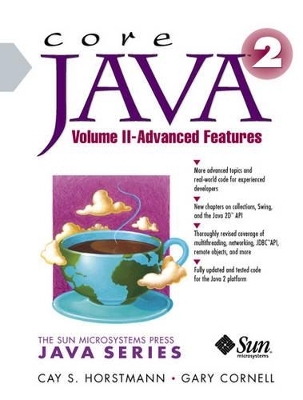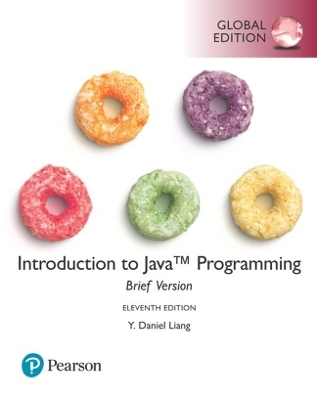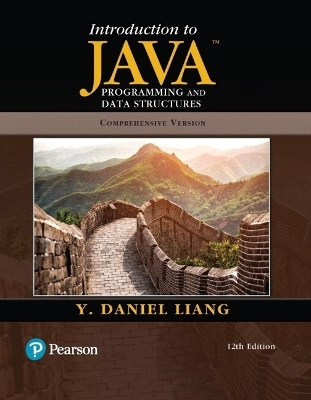
Core Java™ 2, Volume II--Advanced Features
Prentice Hall
978-0-13-081934-5 (ISBN)
- Titel erscheint in neuer Auflage
- Artikel merken
For courses in intermediate Java programming or object-oriented programming.
Core Java, Volume II has been completely revised to reflect new Java 2 capabilities with three completely new chapters and thousands of lines of new code. Core Java, Volume 2 is the source for expert guidance on Java 2 multithreading, networking, database connectivity, remote objects, JavaBeans, CORBA support, security, native methods, drag-and-drop, pluggable look-and-feel, and much more.
Cay S. Horstmann teaches at San Jose State University. In addition to co-authoring the best-selling Core Java, he has written two books on C++/object-oriented development, and is a columnist for C++ Report and Java Report.
1. Multithreading.
What Are Threads? Using Threads to Give Other Tasks a Chance. Running and Starting Threads. Running Multiple Threads. Thread Properties. Thread States. Moving Out of a Blocked State. Dead Threads. Interrupting Threads. Thread Priorities. Selfish Threads. Thread Groups. Synchronization. Thread Communication Without Synchronization. Synchronizing Access to Shared Resources. Object Locks. The Wait and Notify Methods. Deadlocks. Why the Stop and Suspend Methods Are Deprecated. Animation. The Runnable Interface. Loading and Displaying Frames. Using a Thread to Control the Animation. Timers. Daemon Threads. Threads and Swing. Using Pipes for Communication Between Threads.
2. Collections.
Collection Interfaces. Separating Collection Interfaces and Implementation. Collection and Iterator Interfaces in the Java Library. Concrete Collections. Linked Lists. Array Lists. Hash Sets. Tree Sets. Maps. The Collections Framework. Views and Wrappers. Bulk Operations. Interfacing with Legacy APIs. Algorithms. Sorting and Shuffling. Binary Search. Simple Algorithms. Writing Your Own Algorithms. Legacy Collections. The Hashtable Class. Enumerations. Property Sets. Bit Sets.
3. Networking.
Connecting to a Server. Implementing Servers. Serving Multiple Clients. Sending E-mail. URL Connections. Retrieving Information from a Remote Site. Posting Form Data. CGI Scripts and Servlets. Sending Data to a Web Server. Harvesting Information from the Web. Applet Security. Proxy Servers. Testing the WeatherReport Applet.
4. Database Connectivity: JDBC.
The Design of JDBC. Typical Uses of JDBC. The Structured Query Language. Installing JDBC. Basic JDBC Programming Concepts. Database URLs. Making the Connection. Executing Action Commands. Querying with JDBC. Advanced SQL Types (JDBC 2). Populating a Database. Batch Updates (JDBC 2). Executing Queries. Metadata. Scrollable and Updatable Result Sets. Scrollable Result Sets (JDBC 2). Updatable Result Sets (JDBC 2).
5. Remote Objects.
Introduction to Remote Objects: The Roles of Client and Server. Remote Method Invocations. Stubs and Parameter Marshalling. Dynamic Class Loading. Setting Up Remote Method Invocation. Interfaces and Implementations. Locating Server Objects. The Client Side. Preparing for Deployment. Deploying the Program. Parameter Passing in Remote Methods. Passing Nonremote Objects. Passing Remote Objects. Using Remote Objects in Sets. Cloning Remote Objects. Inappropriate Remote Parameters. Using RMI with Applets. Java IDL and CORBA. The Interface Definition Language. A CORBA example. Implementing CORBA Servers.
6. Advanced Swing.
Trees. Tables. A Simple Table. Table Models. Cell Rendering and Editing. Working with Rows and Columns. Styled Text Components. Sliders and Progress Meters. Sliders. Progress Bars. Progress Monitors. Monitoring the Progress of Input Streams. Tool Bars and Tool Tips. Tool Tips. Component Organizers. Split Panes. Tabbed Panes. Desktop Panes and Internal Frames.
7. Advanced AWT.
The Rendering Pipeline. Shapes. Areas. Strokes. Paint. Coordinate Transformations. Clipping. Transparency and Composition. Rendering Hints. Image Manipulation. Accessing Image Data. Filtering Images. Printing. Printing Single Sheets. Printing Multiple Pages. Print Preview. The Clipboard. Classes and Interfaces for Data Transfer. Transferring Text. Building a Transferable. Building an Image Transferable. Using the ImageSelection Class. Transferring Java Objects via the System Clipboard. Drag and Drop. Drop Targets. Drag Sources.
8. JavaBeans?
Why Beans? The Bean-Writing Process. The BDK and the BeanBox. Using the BeanBox. Building an Image Viewer Application via Beans. Naming Patterns for Bean Properties and Events. Bean Property Types. Simple Properties. Indexed Properties. Bound Properties. Constrained Properties. Adding Custom Bean Events. Property Editors. Writing a Property Editor. Going beyond Naming Patterns-Building a BeanInfo Class. FeatureDescriptor Objects. Customizers. Writing a Customizer Class. The Bean Context. Advanced Uses of Introspection. Finding Sibling Beans. Using Bean Context Services.
9. Security.
Class Loaders. Writing Your Own Class Loader. Bytecode Verification. Security Managers and Permissions. Java 2 Platform Security. Security Policy Files. Custom Permissions. Implementing a Permissions Class. A Custom Security Manager. The java.security Package. Message Digests. Digital Signatures. Authentication. The X.509 Certificate Format. Generating Certificates. Signing Certificates. Code Signing. Signing JAR Files. Deployment Tips. Software Developer Certificates.
10. Internationalization.
Locales. Numbers and Currencies. Date and Time. Text. Collation (Ordering). Text Boundaries. Message Formatting. Choice Formats. Character Set Conversion. International Issues and Source Files. Resource Bundles. Locating Resources. Placing Resources into Bundles. Graphical User Interface Localization. Localizing an Applet.
11. Native Methods.
Calling a C Function from the Java Programming Language. Working with the printf Function. Numeric Parameters and Return Values. Using printf for Formatting Numbers. String Parameters. Calling sprintf in a Native Method. Accessing Object Fields. Accessing Static Fields. Signatures. Calling Java Methods. Nonstatic Methods. Static Methods. Constructors. Alternative Method Invocations. Arrays. Error Handling. The Invocation API. A Complete Example: Accessing the Windows Registry. An Overview of the Windows Registry. A Java Platform Interface for Accessing the Registry. Implementing the Registry Access Functions as Native Methods.
Index.
| Erscheint lt. Verlag | 7.1.2000 |
|---|---|
| Verlagsort | Upper Saddle River |
| Sprache | englisch |
| Maße | 178 x 230 mm |
| Gewicht | 1863 g |
| Themenwelt | Informatik ► Programmiersprachen / -werkzeuge ► Java |
| Mathematik / Informatik ► Informatik ► Web / Internet | |
| ISBN-10 | 0-13-081934-4 / 0130819344 |
| ISBN-13 | 978-0-13-081934-5 / 9780130819345 |
| Zustand | Neuware |
| Informationen gemäß Produktsicherheitsverordnung (GPSR) | |
| Haben Sie eine Frage zum Produkt? |
aus dem Bereich

